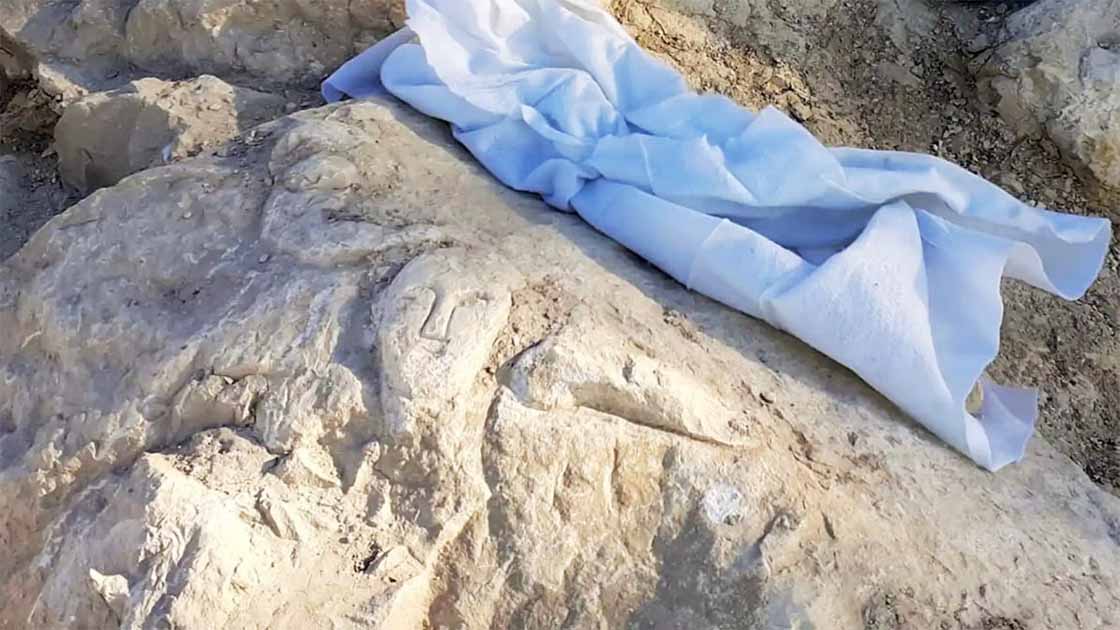Roman Carvings of a Smiley Face and a Phallus Found in Spain
Archaeologists in Spain were exploring an ancient Roman fort when they discovered a carved smiley-face, a basket of fruits and a phallus. For answers as to what this carving means, we must delve into Roman mythology, and into the Romans efforts to persuade the forces of nature.
Located near the Mediterranean Sea in the municipality of Benidorm, on the southeastern coast of Spain, Tossal de La Cala is often described as a hilltop ‘fort’ with an extensive necropolis. Dating back to the Bronze Age, archaeologists have recovered pottery, tools, and ornaments, suggesting this site was an ancient trading hub that connected local farmers with other Mediterranean cultures.
According to Arkeonews, a team of researchers from the University of Alicante have discovered a 2,000-year-old rock carving known as an “inscultura face,” comprising a human face, a cornucopia, and a phallus.
General Quinto Sertorio’s Legacy
Spanish historians often claim Tossal de La Cala was built by General Quinto Sertorio around the year 77 BC, during the Sertorian civil wars, which were fought between 80 to 72 BC. Sertorius was a prominent Roman military commander and statesman during the late Roman Republic era, who demonstrated exceptional leadership skills and military acumen.
During the Sertorian War, General Quinto led a rebellion against the Roman Senate's authority in Hispania (modern-day Iberian Peninsula), and after he formed alliances with local tribes, he employed guerrilla warfare tactics to resist the Roman forces. And while there is no direct evidence, it is generally agreed that Tossal de La Cala was built by General Quinto Sertorio.
What Exactly Was Tossal de La Cala?
Before we look at the three-part caving, we should first clear up exactly what Tossal de La Cala was, as reports call it both a fort and a “castellum.” A fort, or fortress, was a military stronghold used to defend a specific area, and as such they have multiple defensive features such as walls, towers, and moats.
On the other hand, a "castellum" is a specific term used in Roman military architecture referring to a much smaller fortification that was primarily used for securing and controlling water sources, such as springs, aqueducts, water channels, reservoirs, and control mechanisms. Tossal de La Cala was part of a chain of coastal military enclaves which monitored maritime trade and protected the shore from enemy ships, which suggests a defensive role. However, without extensive excavations it is difficult to categorise Tossal de La Cala as either a fort or a castellum, definitively.
- 2,000-Year-Old Roman Phallus Could Be Oldest Known Sex Toy
- Pompeii fresco depicts hapless Priapus with a painful condition
Measuring Up the Ancient Smiley-Face
The carving, which resembles a smiley-face emoji, measures 57 x 42 centimetres (22.44 x 16.53 in). The researchers said the carving is in an incomplete state, because the upper right section is now missing. However, two distinct features have enabled the archaeologists to make assumptions as to the meaning, and purpose, of this ancient artwork.
In ancient Roman culture the phallus symbol was associated with three different concepts: fertility, power, and good luck. In terms of fertility, the Roman phallus symbolized masculine generative power, virility, and the ability to procreate, but also agricultural abundance. This is why the symbol was often associated with the god Priapus, who was the guardian of gardens, livestock, and male genitalia.
Regarding power and good luck, the phallus was believed to offer wearers spiritual protection, in that it could ward off evil. This is why clay phallus’ were commonly worn as “fascinus” (phallic amulets) and hung above doorways, so as to avert the "evil eye" (malus oculus). In reality, the evil eye was often seen as resulting from jealousy over someone's prosperity, success, or good fortune, and the jealous person’s envious gaze was believed to bring about negative consequences, like a curse on the recipient.

Ancient fresco of the Roman god Priapus, Pompeii. Source: BlackMac / Adobe Stock.
The Horn of Plenty
The carved depiction of a cornucopia, or Horn of Plenty, was also a symbol of abundance and prosperity. This mythical horn, or horn-shaped basket overflowing with fruits, veg and flowers, represented endless supplies of food, drink, and other resources. Therefore, it was often associated with the goddess Fortuna, who was the personification of luck and agricultural success, and abundance.
In conclusion, when the three parts of this carving are read together: the happy face, the phallus and the cornucopia speak of virility, abundance, agricultural success and happiness. If so, this means the carved face is most probably a representation of the god who provided these things: Priapus.
Looking for supporting evidence, we might consider the 1616 AD work of Pietro Bernini (1562 AD – 1629 AD) and his son, the sculptor Gian Lorenzo Bernini (1598 AD – 1680 AD), who carved two statues for the gardens of the Villa Borghese in Rome. With half-bodies merging into a tapering pedestal, the god Priapus holds a cornucopia spilling with fruits and flowers and Priapus, with an oversized phallus, symbolising spring and autumn, and abundance in nature and agriculture.
Top image: Roman smiley face carving discovered in Spain. Source: Credit: University of Alicante.
By Ashley Cowie



















